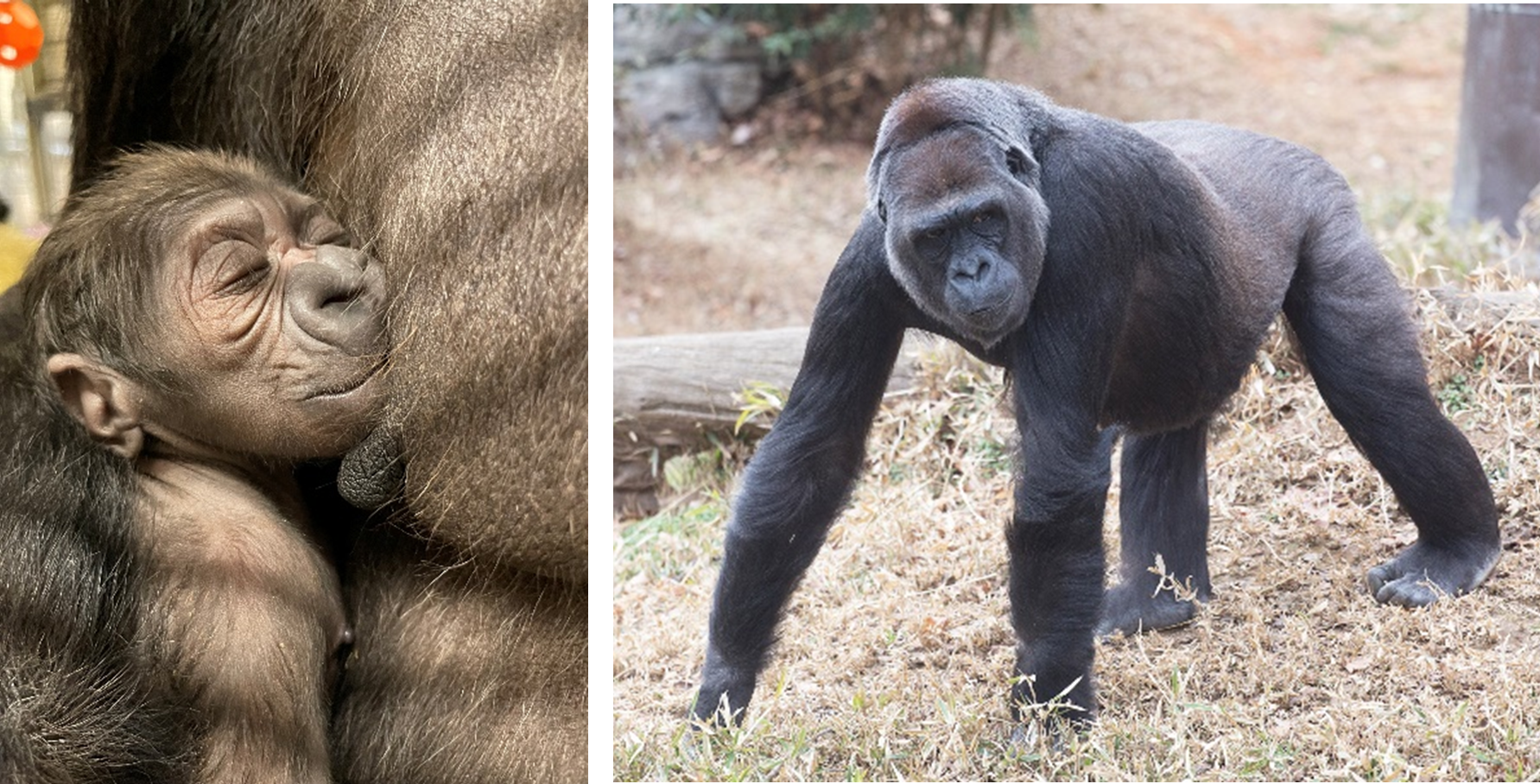Western Lowland Gorilla Born at the Smithsonian’s National Zoo and Conservation Biology Institute

Left: Newborn gorilla cradled by mother Calaya, a 20-year-old female western lowland gorilla. She gave birth to her second offspring May 27 at the Smithsonian’s National Zoo and Conservation Biology Institute. (Photo by Valerie Schultz, Smithsonian’s National Zoo and Conservation Biology Institute)
Right: Calaya, a 20-year-old female western lowland gorilla, gave birth to her second offspring May 27 at the Smithsonian’s National Zoo and Conservation Biology Institute.(Photo by Skip Brown, Smithsonian's National Zoo and Conservation Biology Institute)
For the first time in five years, primate staff at the Smithsonian’s National Zoo and Conservation Biology Institute (NZCBI) are celebrating the birth of a western lowland gorilla—a critically endangered species. The infant was born between midnight and 6:15 a.m. May 27 to 20-year-old mother Calaya and 31-year-old father Baraka. They bred in September 2022 following a breeding recommendation from the Association of Zoos and Aquariums’ Species Survival Plan (SSP). This is the second offspring for both parents.
Animal care staff have observed Calaya nursing the infant who has been clinging closely to its mother, and they are cautiously optimistic that the newborn will thrive. They are leaving Calaya to bond with and care for her baby without interference, so it may be some time before they can confirm the infant’s sex.
In October 2022, keepers used a common human pregnancy test to confirm that Calaya had successfully conceived. Because they trained Calaya to participate voluntarily in ultrasounds, they have been able to monitor fetal growth and development throughout the pregnancy. NZCBI announced her pregnancy March 23 and will provide updates on its gorilla troop through its Facebook, Twitter and Instagram channels using the hashtag #GorillaStory. It will continue to share updates, photos and videos of the infant as news breaks.
“We are overjoyed to welcome a new infant to our western lowland gorilla troop,” said Becky Malinsky, curator of primates. “Calaya is an experienced mother, and I have every confidence she will take excellent care of this baby, as she did with her first offspring, Moke. Since his birth in 2018, it’s been wonderful seeing her nurturing and playful side come out. I encourage people to visit our gorilla family and be inspired to help save this critically endangered species in the wild.”
The SSP scientists determine which animals to breed by considering their genetic makeup, health and temperament, among other factors. Keepers describe Calaya’s personality as both protective and cautious, and they are interested to see how a new baby may affect her participation in training sessions. Baraka has a relaxed and playful personality; over the past few years, he has been very tolerant of his 5-year-old son’s antics. Keepers are most excited to see how Moke will react to and interact with his new sibling—especially once the baby becomes active and independent.
Gorillas live in groups, called troops, that are typically composed of a silverback male, one or more blackback males, several adult females and their infant and juvenile offspring. The Zoo’s troop is composed of Calaya, Baraka, Moke and the new infant, as well as a 41-year-old female named Mandara and her 14-year-old daughter, Kibibi.
Native to Africa, western lowland gorillas live in the forests of Gabon, Central Africa Republic, Cameroon, Angola, Equatorial Guinea and Congo. The International Union for Conservation of Nature lists the western lowland gorilla as critically endangered due to habitat loss, disease and poaching. Scientists estimate that in the past 20 to 25 years, the number of wild western lowland gorillas has decreased by 60%.
The public can help protect western lowland gorillas’ natural habitat by making environmentally conscious decisions like recycling. One of the metals inside electronic devices, tantalum, is mined from areas in the Democratic Republic of the Congo where gorillas live. Tantalum is extracted from the ore Columbite-tantalite (commonly known as coltan). Coltan excavation has resulted in gorilla habitat destruction, and many of the apes fall victim to poachers because of this practice. Recycling electronics that contain tantalum—including cell phones, computers, tablets, cameras, gaming consoles, hearing aids and GPS navigation systems—can help protect gorilla habitat by greatly reducing the demand for more expansive coltan mining.
Note: Reporters will not be able to come to the Zoo for photos or video inside the Great Ape House; b-roll and photos are available online. Zoo staff are busy monitoring Calaya and her newborn and are not available for interviews at this time.
Calaya and her infant will be on exhibit; however, she always has access to off-exhibit areas and may choose to spend time in a more private location. If Calaya is not on view, visitors may see the Zoo’s other gorillas—Baraka, Mandara, Kibibi and Moke—and
# # #
Jen Zoon
301-908-3102
Media website: https://nationalzoo.si.edu/news
To download b-roll and photos, visit the Zoo’s newsroom.
Note: Zoo staff are busy monitoring Calaya and her newborn and are not available for interviews at this time.
